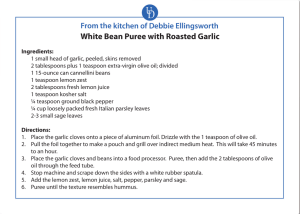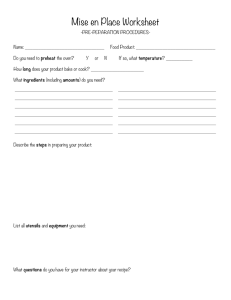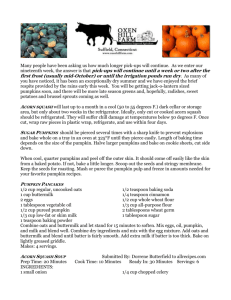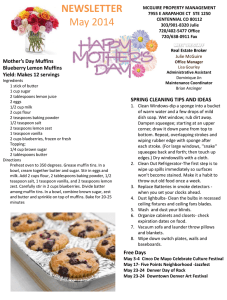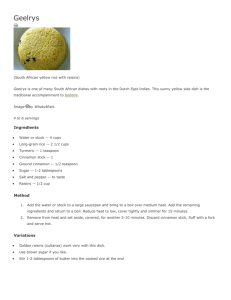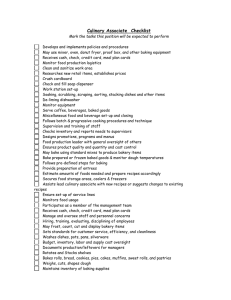C O T OOKING
advertisement
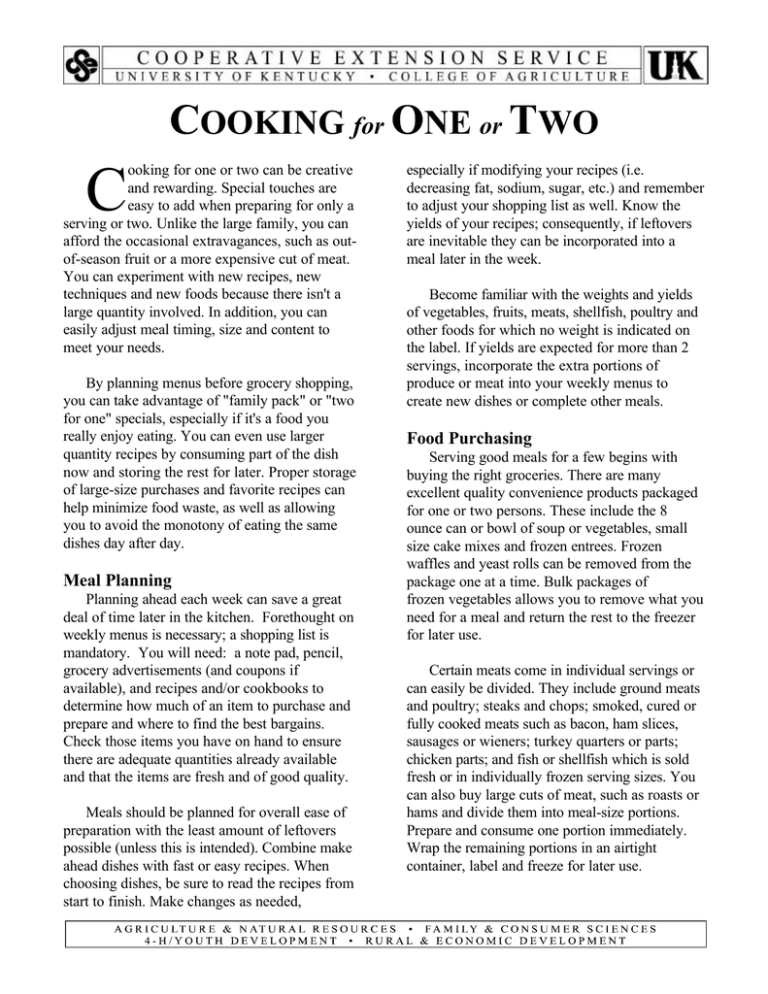
COOKING for ONE or TWO ooking for one or two can be creative and rewarding. Special touches are easy to add when preparing for only a serving or two. Unlike the large family, you can afford the occasional extravagances, such as outof-season fruit or a more expensive cut of meat. You can experiment with new recipes, new techniques and new foods because there isn't a large quantity involved. In addition, you can easily adjust meal timing, size and content to meet your needs. C By planning menus before grocery shopping, you can take advantage of "family pack" or "two for one" specials, especially if it's a food you really enjoy eating. You can even use larger quantity recipes by consuming part of the dish now and storing the rest for later. Proper storage of large-size purchases and favorite recipes can help minimize food waste, as well as allowing you to avoid the monotony of eating the same dishes day after day. Meal Planning Planning ahead each week can save a great deal of time later in the kitchen. Forethought on weekly menus is necessary; a shopping list is mandatory. You will need: a note pad, pencil, grocery advertisements (and coupons if available), and recipes and/or cookbooks to determine how much of an item to purchase and prepare and where to find the best bargains. Check those items you have on hand to ensure there are adequate quantities already available and that the items are fresh and of good quality. Meals should be planned for overall ease of preparation with the least amount of leftovers possible (unless this is intended). Combine make ahead dishes with fast or easy recipes. When choosing dishes, be sure to read the recipes from start to finish. Make changes as needed, especially if modifying your recipes (i.e. decreasing fat, sodium, sugar, etc.) and remember to adjust your shopping list as well. Know the yields of your recipes; consequently, if leftovers are inevitable they can be incorporated into a meal later in the week. Become familiar with the weights and yields of vegetables, fruits, meats, shellfish, poultry and other foods for which no weight is indicated on the label. If yields are expected for more than 2 servings, incorporate the extra portions of produce or meat into your weekly menus to create new dishes or complete other meals. Food Purchasing Serving good meals for a few begins with buying the right groceries. There are many excellent quality convenience products packaged for one or two persons. These include the 8 ounce can or bowl of soup or vegetables, small size cake mixes and frozen entrees. Frozen waffles and yeast rolls can be removed from the package one at a time. Bulk packages of frozen vegetables allows you to remove what you need for a meal and return the rest to the freezer for later use. Certain meats come in individual servings or can easily be divided. They include ground meats and poultry; steaks and chops; smoked, cured or fully cooked meats such as bacon, ham slices, sausages or wieners; turkey quarters or parts; chicken parts; and fish or shellfish which is sold fresh or in individually frozen serving sizes. You can also buy large cuts of meat, such as roasts or hams and divide them into meal-size portions. Prepare and consume one portion immediately. Wrap the remaining portions in an airtight container, label and freeze for later use. Here's a good example of how a thick beef chuck arm pot roast can be used for more than one meal. Cut the pot roast into thirds. Use the round end for beef stew, the center for one-meal pot roast and the remaining third for two Swiss steaks. A full shank half of ham can also be utilized for more than one meal. Ask the butcher to cut through the bone. Prepare a boiled dinner with the shank end. With the remaining two portions, bake the bone-in half and slice the other to broil. There are fruits and vegetables that by nature are individual portions. They keep well a week or more and are served either raw or cooked. Good fresh vegetable choices include artichokes, beets, cabbage, carrots, cauliflower, celery, cucumbers, green peppers, eggplant, kohlrabi, leeks, onions, potatoes, radishes, romaine lettuce, rutabagas, squash, sweet potatoes, tomatoes and turnips. Good fresh fruit choices include apples, avocados, bananas, citrus fruit, melons, nectarines, peaches and pears. Refrigerator Storage Maintain refrigerator temperature around 35°. Check the temperature weekly. Store meat, fish and dairy foods in the coldest section. Produce is best stored in a produce drawer. Refrigerate opened staples, such as peanut butter, jams and jellies, ground coffee, cooking oil, nuts and flour, to maintain the freshest flavor. Use food as quickly as possible for best flavor, nutritional value and overall quality. the ends over and pressing them together. The drugstore wrap consists of placing the food on a sheet of foil. Allow room for folding at the top and sides. Bring two sides together above the food. Fold foil over and down in locked folds tight against food, pressing the air out. Mold foil to food and fold the short ends up and over again. Press out air and crimp ends. The casserole wrap consists of lining a casserole with foil, leaving a 1½ inch collar around the edges. Add food and cover with foil the size of the dish plus the collar. Press out the air and fold the edges up and over and press together. Label and freeze. When frozen solid, lift wrapped food from dish and return food to the freezer. Techniques for Easy Cooking Double batch cooking gives you two meals with one preparation time. Cook a full recipe. Serve one portion now and freeze the rest. Bundle wrap odd shaped or semi-moist foods or cook in oven cooking bags. Place half of the food in one bag and seal. Follow the directions of the cooking bag and cook. Place the remaining food in a second bag. Mold the bag close to food to remove the air, seal and freeze. If freezing for more than a month, overwrap. For economy, plan the portion size. Use small-size aluminum foilware for single servings. Cook, serve and store in the same pan. Wrap individual servings of meats in foil for cooking and storing or in individual baking dishes that can be sealed. Make a complete meal for one in a dish with compartments. Cover, freeze and cook in the same tray. Freezer Storage Be sure to label packages, noting the contents and date of preparation. The faster food freezes, the better. Taste, texture and nutritional quality all suffer when freezer temperature exceeds 0°. Besides airtight containers and specially designed cookware, there are three ways to wrap food for the freezer. The bundle wrap consists of placing odd-shaped food or semi-moist food on a square of heavy duty aluminum foil. Bring the four corners together in a pyramid shape and squeeze the foil close to the food. Seal by folding Foods than have been frozen in cooking bags can be taken directly from the freezer to the oven. Allow ½ to a more cooking time for the same thawed food. Prepared casseroles that have been frozen in aluminum foilware need to have the cooking time increased by one half. Lightly grease aluminum foil; wrap around seasoned frozen fish. Bake ½ to a longer than for the same thawed fish. FN-SSB.106 | Page 2 of 4 Meal Service Tableware—dinner plates, dessert and/or salad plates, soup and/or cereal bowls, cups and saucers and/or mugs; purchase at least enough to serve four. Be creative with mix and match pieces or one-of-a-kind items found at flea markets, yard sales, or antique stores. Flatware—forks, knives, teaspoons; purchase at least enough to serve four. If possible, add salad or dessert forks, soup spoons, steak knives, and serving bowls and platters to your list. Glassware—If short on space or money, purchase 10 ounce stemmed goblets since these are useful as all-purpose glasses. Or, add regular water tumblers, juice, wine, and iced-tea glasses when possible. Table Linens—use place mats with matching or contrasting napkins in both paper and fabric; tablecloths can be added for special occasions. Table Accessories—candles, vases, napkin holders, doilies, trivets, centerpieces (i.e. flowers, fruit baskets, collection pieces, etc.) can add interest to your table's decor. Look for unusual pieces at garage sales, flea markets, and special store events. Accessories can individualize your table and set the tone for the meal. If your particular situation warrants being thrifty, then eliminate those items considered "extra". Store, sell or give away the rest. Depart from the ordinary and do the unexpected when setting your table. Make your meal fun and enjoyable - even if it is a meal for one! Yield: 2 servings 2 pork loin chops c teaspoon onion powder ½ teaspoon salt (optional) 2 tablespoons dry white wine Dash pepper 1 can (7½ oz.) semi-condensed cream of mushroom soup ¼ teaspoon ground ginger 6 tablespoons instant rice Brown pork chops. Combine remaining ingredients; divide evenly between two foil sheets. Place pork chops on rice. Follow directions for bundle wrap, except fold foil Elegant Pork Chops loosely. Place in supporting pan. Bake in 350° oven 40 minutes. Open foil, bake 5 minutes. Nutritional Analysis: 530 Calories, 26 g protein, 23 g carbohydrate, 35 g fat, 88 mg cholesterol, 1199 mg sodium. Veal Parmesan Yield: 2 servings 3 tablespoons cracker crumbs b cup tomato sauce 3 tablespoons grated Parmesan cheese c teaspoon leaf oregano Dash pepper ¼ teaspoon salt (optional) 1 egg, well beaten c teaspoon garlic powder 2 tablespoons dry white wine, divided (optional) ¼ cup shredded Mozzarella cheese 2 veal cutlets, 4 oz. each Pound veal until ¼-inch thick. Combine cracker crumbs, Parmesan cheese and pepper. Combine egg and 1 tablespoon wine. Dip each cutlet in egg mixture; coat with cracker mixture. Arrange cutlets in lightly greased foilware pan. bake in 400° oven for 20 minutes. Combine remaining wine, tomato sauce, oregano, salt and garlic powder and spoon over cutlets; top with Mozzarella. Bake 7 to 10 minutes longer or until cheese melts. Nutritional Analysis: 511 Calories, 47 g protein, 14 g carbohydrate, 28 g fat, 255 mg cholesterol, 1204 mg sodium. Yield: 2 servings ¾ pound beef chuck arm steak, boneless, cut 1inch thick ¼ cup burgundy wine (optional) ¼ cup water 1 medium potato, pared and quartered ¼ teaspoon salt (optional) 1 carrot, pared and quartered c teaspoon pepper 1 envelope instant onion soup mix (1 cupserving) 1 bay leaf Place chuck steak and vegetables in ovencooking bag. Combine remaining ingredients. Close bag with tie. marinate in refrigerator overnight. Make 6 half-inch slits in top of bag. Cook in 350° oven, 1 to 1¼ hours or until tender. Remove bay leaf before serving. Burgundy Pot Roast FN-SSB.106 | Page 3 of 4 Nutritional Analysis: 698 Calories, 48 g protein, 20 g carbohydrate, 44 g fat, 169 mg cholesterol, 703 mg sodium. Apple Stuffed Squash Yield: 2 servings 1 small to medium acorn squash 2 tablespoons raisins ¼ teaspoon salt, divided (optional) 2 tablespoons brown sugar 2 tablespoons butter or margarine ½ teaspoon ground ginger 1 apple, cored and thinly sliced ¼ teaspoon ground nutmeg Parboil squash 5 minutes for easy cutting; cool to handle. Cut squash in half; scoop out seeds. Sprinkle c teaspoon salt on each half. In fry pan , melt butter; lightly saute apple slices and raisins; add sugar and spices. Fill squash halves with apple mixture. Place each stuffed squash on a foil sheet. Follow directions for bundle wrap, except fold the openings together loosely to allow for heat circulation and expansion. Place one bundle on supporting pan. Bake in 350° oven 45 to 55 minutes or until squash is tender. Freeze second bundle. When ready to serve, bake in 400° oven 50 to 60 minutes. Nutritional Analysis: 379 Calories, 4 g protein, 73 g carbohydrate, 12 g fat, 390 mg sodium. Sinful Chocolate Pecan Pie Yield: 2 servings 1 (4½-inch) baked tart shell 2 eggs, slightly beaten ¼ cup sugar ½ teaspoon vanilla 1 tablespoon water ½ teaspoon butter or margarine, melted 1 (1.2 oz.) dark chocolate candy bar OR 1 square (1 oz.) semi-sweet chocolate c teaspoon salt ½ cup coarsely chopped pecans In small saucepan, combine sugar and water; cook over medium heat until sugar dissolves and mixture is bubbly. Remove from heat. Stir in chocolate and heat until chocolate is melted. Cool slightly. Stir in eggs, vanilla, butter and salt. Fold in pecans. Pour into shell. Bake in 350° oven 40 to 50 minutes or until set. Cool before serving. Nutritional Analysis: 647 Calories, 12 g protein, 57 g carbohydrate, 44 g fat, 212 mg cholesterol, 298 mg sodium. Other CES HE pubs that you may find helpful in meal preparation: HE 3-106, Vegetable Preparation for the Family HE 3-124A, Salad Savvy HE 3-127, Seafood: Finfish and Shellfish HE 3-227, Quick Nutritious Meals HE 3-503, Freezing Prepared and Cooked Foods Yield: 2 servings 1 can (8½ oz.) whole kernel corn, drained Dash pepper 1 tablespoon sugar 1 egg, beaten 1 tablespoon flour 1 tablespoon butter or margarine, melted ½ teaspoon salt (optional) ½ cup milk Combine corn, sugar, flour, salt and pepper. Stir in remaining ingredients. Pour in mini loaf pan foilware. Bake in 325° oven 50 to 60 minutes, or until knife comes out clean. Corn Pudding Nutritional Analysis: 255 Calories, 9 g protein 35 g carbohydrate, 11 g fat, 111 cholesterol, 1038 mg sodium. Sandra Bastin, Ph.D., R.D., L.D. Extension Specialist, Food & Nutrition Educational programs of the Kentucky Cooperative Extension Service serve all people regardless of race, color, age, sex, religion, disability, or national origin. Issued in furtherance of Cooperative Extension work, Acts of May 8 and June 30, 1914, in cooperation with the U.S. Department of Agriculture, C. Oran Little, Director of Cooperative Extension Service, University of Kentucky College of Agriculture, Lexington, and Kentucky State University, Frankfort. Selected publications are also available on the World Wide Web at http://www.ca.uky.edu. Issued 08-1994; FN- SSB.016 FN-SSB.106 | Page 4 of 4
